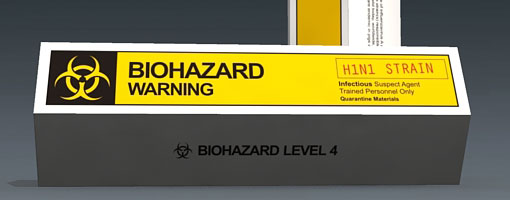
This model is fictitious virus container. Influenza A virus subtype H1N1, also known as A(H1N1), is a subtype of influenzavirus A and the most common cause of influenza (flu) in humans. Some strains of H1N1 are endemic in humans, including the strain(s) responsible for the 1918 flu pandemic which killed 50–100 million people worldwide. Less virulent H1N1 strains still exist in the wild today, worldwide, causing a large fraction of all seasonal influenza and roughly half of all flu infections in 2006. Other strains of H1N1 are endemic in pigs and in birds. [Wikipedia]

In March and April 2009, an outbreak of H1N1 influenza in Mexico led to hundreds of confirmed cases and a number of deaths. As of April 28, the new strain was suspected to have infected more than 2,500 individuals worldwide, with 152 attributed deaths. The U.S. Centers for Disease Control and Prevention warned that it was possible the outbreak could develop into a pandemic. On April 27, 2009, the World Health Organization raised their alertness level from 3 to 4 (on a scale of 6) worldwide in response to sustained human-to-human transfer of the virus. The situation was raised to level 5 (pandemic imminent) on April 29, 2009 by the World Health Organization. [Wikipedia]

SWINE FLU
The swine influenza virus isolated from patients in the United States was found to be made up of genetic elements from four different flu viruses – North American Mexican influenza, North American avian influenza, human influenza, and swine influenza virus typically found in Asia and Europe – "an unusually mongrelised mix of genetic sequences." This new strain appears to be a result of reassortment of human influenza and swine influenza viruses, in all four different strains of subtype H1N1. However, as the virus has not yet been isolated in animals to date and also for historical naming reasons, the World Organisation for Animal Health (OIE) suggests it be called "North-American influenza". On April 30, 2009 the World Health Organization began referring to the outbreak as "Influenza A (H1N1)" instead of "swine flu", presumably to countermand the consequences of the misleading less scientifically labeled name as referenced by WHO spokesperson Dick Thompson.
Several complete genome sequences for U.S. flu cases were rapidly made available through the Global Initiative on Sharing Avian Influenza Data (GISAID). Preliminary genetic characterization found that the hemagglutinin (HA) gene was similar to that of swine flu viruses present in U.S. pigs since 1999, but the neuraminidase (NA) and matrix protein (M) genes resembled versions present in European swine flu isolates. The six genes from American swine flu are themselves mixtures of swine flu, bird flu, and human flu viruses. While viruses with this genetic makeup had not previously been found to be circulating in humans or pigs, there is no formal national surveillance system to determine what viruses are circulating in pigs in the U.S. [Wikipedia]
